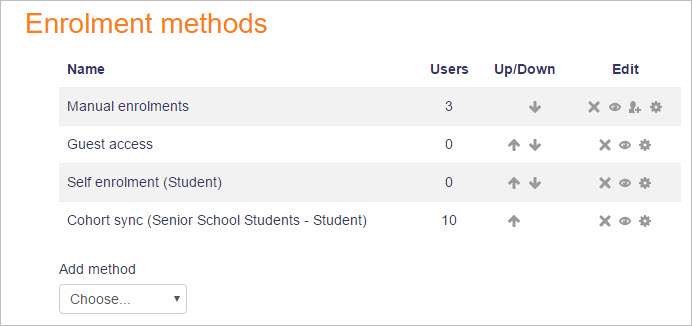- Participants
- Enrollment methods
- Enrollment key
- Unenrollment
- Other users
Contents
Enrollment methods
Depending upon which enrollment methods are enabled for the site (by an administrator in Site administration > Plugins > Enrollments > Manage enroll plugins), some or all of the following are available within a course:
Manual enrollment
- This enables users to be enrolled manually in Course administration > Users > Enrolled users.
- It allows the instructor of the course to manage individual or collective enrollment to their course themselves – for example: if a new user arrives to class unexpectedly with just a login to the site, they may be enrolled by the instructor into their course without any input from an administrator.
- See Manual enrollment for full details of how this can work in your course.
Self enrollment
- This allows users to enroll themselves into a course, either directly or via an enrollment key (“course password”) The instructor does not then have to manually add users.
- More than one instance of the self enrollment method can be used so that when users enroll themselves they are assigned different roles e.g. certain users can be assigned the role of user and other users can be assigned the role of non-editing instructor
- The self-enrollment method also allows for users to enroll themselves into groups by using a group enrollment key.
- See Self enrollment for full details of how this can work in your course.
Guest access
- This allows those with the guest role to view the contents of a course.
- Users with the “guest role” may be visitors who do not have an account on your LMS, or users who do have an account (“authenticated users”) but who would just like to explore your course.
- It is possible to add an enrollment key so that only those guest users you wish to grant access can enter the course
- Entering a course with guest access doesn’t allow a user to participate in any activities; they can only view information.
- See Guest access for full details of how this can work in your course.
Cohort sync
- A cohort is a set of users which has been added either to the site as a whole or to a particular category and which can then be made available in a course through the cohort-sync enrollment plugin.
- Only an administrator or a manager can use this plugin.
- See Cohort sync for full details of how this can work in your course.
Course meta link
- This allows users who are in another course to be automatically enrolled into your course as well. An example might be if a LMS site has a course for “Staff Only” and a course for “LMS Help”. If the “Staff Only” course is added to the “LMS Help” course with the course meta link plugin, then every time a new member of staff joins the “Staff Only” course, they will automatically be enrolled in the “LMS Help” course as well.
- Instructors can only select from courses in which they are instructors when using this method.
- See Course meta link for full details of how this can work in your course.
PayPal
- This allows users to pay for a course. The PayPal enrollment plugin needs to be enabled sitewide by the administrator and the plugin needs to be added to a course by the administrator or a manager.
- The course instructor can select a cost(and currency for their course) along with other course-specific requirements.
- See PayPal enrollment for full details of how this can work in your course.
Managing enrollment methods

Managers and instructors (and any other users with the capability lms/course:enrollconfig) can manage enrollment methods in Course administration > Users > Enrollment methods.
- To add a new method, select it from the drop-down menu.
- To remove any unused enrollment method, click the delete icon (X) opposite it.
- To temporarily disable an enrollment method, click the show/hide icon (an eye) opposite it. (This ensures that the settings are remembered if the enrollment method is later re-enabled.)
- If several self-enrollment methods are enabled, the order in which they are listed for users wanting to enroll can be changed with the up/down arrows.
See also

